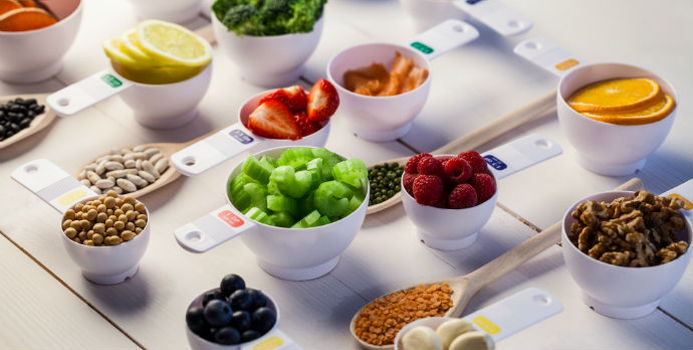If you're trying to lose weight or have already achieved your goal weight but need to maintain that healthy weight, you know that portion control is a key component of a healthy eating pattern. However, life happens and sometimes, even with the best intentions, you overdo it on portion sizes. Here are few simple tricks to help you keep portions in check while enjoying a variety of flavorful, nutritious foods.
Start Measuring
I’ll let you in on a little secret: those measuring cups and measuring spoons can do so much more than help you bake the perfect cake — they're splendid for helping you measure out the proper portions of food. Rather than guessing how much one cup of popcorn or two tablespoons of salad dressing are, measure it out.
Find a Food Scale
Even more precise than measuring cups and spoons is a digital food scale. This works particularly well for measuring raw and cooked meat, poultry, and seafood. You can easily purchase a high-quality digital food scale online and in stores for around twenty bucks or less.
Keep a Food Journal
Multiple studies have proven that the simple practice of keeping a food journal — whether it be on a smartphone app or simply with pen and paper — can help people lose twice as much as weight as those who do not keep a food journal. The reason that writing down everything you eat works so well at helping you nail portion control once and for all is due to the fact that it increases your awareness of when, why, and how much you are eating. This, in turn, helps you fend off mindless munching.
Pick Plenty of Produce
Aim to make at least half of your plate (or bowl, or box) non-starchy vegetables, and try to fill one-quarter with lean protein and one-quarter with grains or other carbohydrates, such as fruit or legumes. Since vegetables are naturally low in calories, filling up on them will naturally displace higher-calorie fare and keep your total calorie intake down.
Divide and Conquer Large Containers of Snack Foods
This works particularly well with large bags or boxes of potato chips, tortilla chips, pretzels, popcorn, crackers, cereal, and nuts. These are the types of snacks of which you tend to underestimate proper portion size, especially if you eat them directly from the container. For snack foods, especially sweet, salty, or crunchy items that are easy to overeat, re-portion out bulk packages by measuring out the exact portion (count or weigh it) into individual zip-top plastic bags. Write the calorie count on the outside to prevent you from snacking on more than one bag.
Estimate Portion Sizes Using Everyday Items
Eating away from home and not sure what an ounce of cheese looks like? How about three ounces of cooked chicken? Use common items to estimate portion size when you don't have your measuring cups or food scale nearby. For example, a proper portion size of hard cheese is 1 ounce, which is about the size of your thumb, a pair of dice, or a tube of lipstick. A 3-ounce serving of meat, fish, or poultry is about the size of a deck of playing cards. What is the appropriate size of a baked potato? It is equivalent to the size of a computer mouse.
Invest in New Plates and Bowls
Thirty years ago, people were eating off of smaller dinner plates and bowls. What else was smaller three decades ago? America’s waistlines. Stock your kitchen with smaller plates — those that are 8 to 10 inches rather than 12 inches. You may not think plate size would make a significant difference in calorie intake, but au contraire. Research out of Cambridge University analyzed 61 separate studies and found that simply decreasing the size of your plate or bowl decreases total calorie intake by 159 calories per day.
Don’t Split Hairs, Split Dinner
When you are out to dinner with your friends, family, or colleagues, ask if anyone would like to split an entree with you. Most restaurant entrees are humongous — large enough to feed two or three people at a minimum. Your server can split a main dish up onto two plates. You'll save on calories and get a more appropriate portion size, and you'll save money in the process. You and your dinner mates don’t like the same foods? Box up half or your meal in a to-go container (kudos if you're green and bring your own container) as soon as your meal arrives at your table to save half for the next day.
Banish Screen Time During Meals
Eating while you’re distracted by the television or a computer screen will almost guarantee that you will overeat because you are much less aware of how much you’re actually putting in your mouth. Sit down at the dinner table and truly savor each bite of food slowly, listening to your body’s innate cues for hunger and fullness.
Throw Out That Candy Dish
You tend to eat more if you have incredibly easy access to unhealthy food. Get rid of the candy dish or replace the candy with fresh fruit. This establishes that your home is a portion-friendly place. Out of sight, out of mind!
[Image via Shutterstock]



